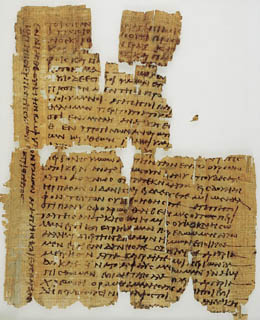|
The Meletian Schism
By the 4th century A.D., the great wars were
over, so it was rare for hordes of defeated peoples to be herded
through the streets and sold one-by-one to the highest bidder. Documents
of the time suggest that the craftsmen in most industries now most
likely were citizens, struggling like everyone around them to balance
life against the relentless burden of taxes.
Nowadays, we look back in wonder at the magnificence
of the churches and palaces that were built in Constantinople
and in other major cities of the Empire by new adherents to
the Christian faith. But this papyrus, the Meletian Schism,
captures all too poignantly the hardship imposed upon the
craftsfolk and farming peasantry during the early Byzantine
era. The text describes the sufferings of a certain wine-dealer,
Pamonthius, who has fallen into so much debt that he was forced
not only to sell all his property and his wardrobe but also
to hand over his children to creditors. Though the pledging
of one’s children as a security—and so, in the eventuality
of default, committing them to a life of slavery—was
illegal, it was widespread.
|
|

Meletian Schism
papyrus
circa A.D. 330
|

